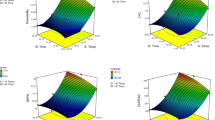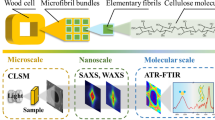Abstract
Thermal modification can change the color and improve the dimensional stability and decay resistance of wood without the use of chemical modifiers. However, the impact of extracts from thermally modified wood (TMW) on the performance of TMW remains obscured. To achieve high-value utilization of TMW extracts and to regulate the properties of the TMW through extracts, the impacts of TMW acetone extracts on the color, dimensional stability, and decay resistance of TMW were investigated. The 180, 200 and 220 °C thermally modified spruce (Picea asperata Mast.) and poplar (Populus tomentosa Carr.) with or without acetone extract were used for CIELab color system, anti-swelling efficiency (ASE), and decay resistance assessments. Fourier infrared spectroscopy (FTIR) and X-ray photoelectron spectroscopy (XPS) were used to characterize extracted and unextracted TMW. The results indicated that the extract showed positive effects on the color, dimensional stability (220 °C), and decay resistance of TMW, and this effect weakened with increasing temperature. The removal of the extract resulted in a reduction in brightness difference (∆L*) and total color difference (∆E*) of the TMW, with the most pronounced impact observed at 180 °C. The removal of the extract enhanced the dimensional stability of the TMW at 180 and 200 °C but decreased it at 220 °C. The decay resistance of wood thermally modified at 180, 200, and 220 C decreased after extraction, and was most significant at 180 °C. The antifungal activity of the extract was related to the production of vanillin, isovanillic acid, syringic acid, and syringaldehyde. Extract from TMW played an important role in the properties of TMW, serving as a potential means for adjusting its properties or as a natural wood modifier.








Similar content being viewed by others
References
Acheampong A, Okyem S, Akoto CO, Baah KA (2018) Antioxidant, antimicrobial and FTIR analysis of methanol root extract of Cnestis ferruginea and ethanol root extract of Citrus limon. J Pharmacogn Phytochem 7(4):2938–2946. https://www.phytojournal.com/archives?year=2018&vol=7&issue=4&ArticleId=5393
Bekhta P, Niemz P (2003) Effect of high temperature on the change in color, dimensional stability, and mechanical properties of spruce wood. Holzforschung 57(5):539–546. https://doi.org/10.1515/HF.2003.080
Bi ZJ, Zhao Y, Morrell JJ, Lei YF, Yan L (2021a) The antifungal mechanism of Konjac flying powder extract and its active compounds against wood decay fungi. Ind Crop Prod 164(1):113406. https://doi.org/10.1016/j.indcrop.2021.113406
Bi ZJ, Yuan JY, Morrell JJ, Yan L (2021b) Effects of extracts on the colour of thermally modified Populus tomentosa Carr. Wood Sci Technol 55:1075–1090. https://doi.org/10.1007/s00226-021-01304-7
Bi ZJ, Morrell JJ, Lei YF, Yan L, Ji MT (2022) Eco-friendly and mildly modification of wood cell walls with heat treated wood extracts to improve wood decay resistance. Ind Crop Prod 184:115079. https://doi.org/10.1016/j.indcrop.2021.113406
Brocco VF, Paes JB, Gonçalves da Costa L, Brazolin S, Arantes MDC (2017) Potential of teak heartwood extracts as a natural wood preservative. J Clean Prod 142:2093–2099. https://doi.org/10.1016/j.jclepro.2016.11.074
Candelier K, Thevenon MF, Petrissans A, Dumarcay S, Gerardin P, Petrissans M (2016) Control of wood thermal treatment and its effects on decay resistance: a review. Ann for Sci 73:571–583. https://doi.org/10.1007/s13595-016-0541-x
Candelier K, Thévenon MF, Collet R, Gérardin P, Dumaray S (2020) Anti-fungal and anti-termite activity of extractives compounds from thermally modified ash woods. Maderas-Cienc Tecnol 22(2):223–240. https://doi.org/10.4067/S0718-221X2020005000209
Chaouch M, Petrissans M, Petrissans A, Gerardin P (2010) Use of wood elemental composition to predict heat treatment intensity and decay resistance of different softwood and hardwood species. Polym Degrad Stabil 95(12):2255–2259. https://doi.org/10.1016/j.polymdegradstab.2010.09.010
Chen Y, Fan YM, Gao JM, Li HK (2012) Coloring characteristics of in situ lignin during heat treatment. Wood Sci Technol 46(1–3):33–40. https://doi.org/10.1007/s00226-010-0388-5
Chu DM, Zhang XY, Mu J, Avramidis S, Xue L, Li YS (2019) A greener approach to byproducts from the production of heat-treated poplar wood: analysis of volatile organic compound emissions and antimicrobial activities of its condensate. J Clean Prod 213:521–527. https://doi.org/10.1016/j.jclepro.2018.12.163
Costa JC, Branco JM, Cames AF (2019) Thermal modification of most representative Portuguese wood species. A preliminary study. Rev Constr 18(3):488–500. https://doi.org/10.7764/RDLC.18.3.488
Dubey MK, Pang SS, Walker J (2011) Effect of oil heating age on colour and dimensional stability of heat-treated pinus radiata. Eur J Wood Prod 69(2):255–262. https://doi.org/10.1007/s00107-010-0431-0
Esteves B, Graça J, Pereira H (2008) Extractive composition and summative chemical analysis of thermally treated eucalypt wood. Holzforschung 62(3):344–351. https://doi.org/10.1515/HF.2008.057
Gadhave RV, Sanjivkasbe P, Mahanwar PA, Gadekar PT (2019) Synthesis and characterization of lignin-polyurethane based wood adhesive. Int J Adhes Adhes 95:102427. https://doi.org/10.1016/j.ijadhadh.2019.102427
Gao S, Chen Y, Gao JM (2015) Effect of extractives on Color changes of Eucalyptus urophylla × Eucalyptus grandis and its Spectrum Analysis. J Northeast for Univ 43(4):73–76. http://doi.org/CNKI:SUN:DBLY 0.2015-04-016
González-Peña MM, Hale MDC (2009) Colour in thermally modified wood of beech, Norway spruce and scots pine. Part 1: Colour evolution and colour changes. Holzforschung 63(4):385–393. https://doi.org/10.1515/HF.2009.078
Hakkou M, Pétrissans M, Gérardin P, Zoulalian A (2006) Investigations of the reasons for fungal durability of heat-treated beech wood. Polym Degrad Stabil 91:393–397. https://doi.org/10.1016/j.polymdegradstab.2005.04.042
Hill C, Altgen M, Rautkari L (2021) Thermal modification of wood-a review: chemical changes and hygroscopicity. J Mater Sci 56(11):6581–6614. https://doi.org/10.1007/s10853-020-05722-z
Huang RF, Lv JX, Cao YJ, Zhao X, Zhao YK, Zhou YD (2010) Impact of heat treatment on chemical composition of Chinese white poplar wood. J Bei**g for Univ 32(3):155–160. https://doi.org/10.3724/SP.J.1011.2010.01351
Huang YG, Li GY, Chu FX (2019) Modification of wood cell wall with water-soluble vinyl monomer to improve dimensional stability and its mechanism. Wood Sci Technol 53(3):1051–1060. https://doi.org/10.1007/s00226-019-01112-0
Inari GN, Petrissans M, Dumarcay S, Lambert J, Ehrhardt JJ, Sernek M, Gerardin P (2011) Limitation of xps for analysis of wood species containing high amounts of lipophilic extractives. Wood Sci Technol 45(2):369–382. https://doi.org/10.1007/s00226-010-0324-8
Jiang JY, Peng Y, Ran YY, Cao JZ (2022) Pseudo lignin formed from hygrothermally treated holocellulose and its effect on fungal degradation. Ind Crop Prod 184:115004. https://doi.org/10.1016/j.indcrop.2022.115004
Källbom S, Moghaddam MS, Walinder MEP (2018) Liquid sorption, swelling and surface energy properties of unmodified and thermally modified scots pine heartwood after extraction. Holzforschung 72(3):251–258. https://doi.org/10.1515/hf-2017-0064
Kamdem DP, Pizzi A, Jermannaud A (2002) Durability of heat-treated wood. Holz Roh- Werkst 60(1):1–6. https://doi.org/10.1007/s00107-001-0261-1
Korenman YI, Mokshina NY, Zykov AV (2010) Distribution coefficients of vitamin B-2 in hydrophilic organic solvent-aqueous salt solution systems. Russ J Phys Chem A 84(3):415–418. https://doi.org/10.1134/S0036024410030131
Korkut S, Akgul M, Dundar T (2008) The effects of heat treatment on some technological properties of scots pine (Pinus sylvestris L.) wood. Bioresource Technol 99(6):1861–1868. https://doi.org/10.1016/j.biortech.2007.03.038
Li HM, Chen RW, Yan T, Chen KH (2009) Chemical composition, decay resistance and mold inhibition of heat-treated lumber. China Wood Ind 23(3):46–48. https://doi.org/10.19455/j.mcgy.2009.03.015
Li RR, Xu W, Wang XD, Wang CG (2018) Modeling and predicting of the color changes of wood surface during CO2 laser modifcation. J Clean Prod 183:818–823. https://doi.org/10.1016/j.jclepro.2018.02.194
Ling Z, Ji Z, Ding DY, Cao JZ, Xu F (2016) Microstructural and topochemical characterization of thermally modified poplar (Populus cathayaha) cell wall Bioresources 11(1):786–799. https://bioresources.cnr.ncsu.edu/resources/microstructural-and-topochemical-characterization-of-thermally-modified-poplar-populus-cathayaha-cell-wall/
Lyu WH, Shi Y, Zheng YX, Liu X (2019) XPS and FTIR studies of fungus-stained Daemonorops margaritae. J for Res 30(2):739–743. https://doi.org/10.1007/s11676-018-0598-5
Mayer I, Koch G, Puls J (2006) Topochemical investigations on wood extractives and their influence on color changes in American black cherry (Prunus serotina Borkh). Holzforschung 60:589–594. https://doi.org/10.1515/HF.2006.100
Mehrotra R, Singh P, Kandpal H (2010) Near infrared spectroscopic investigation of the thermal degradation of wood. Thermochim Acta 507–508:60–65. https://doi.org/10.1016/j.tca.2010.05.001
Metsa-Kortelainen S, Antikainen T, Viitaniemi P (2006) The water absorption of sapwood and heartwood of scots pine and Norway spruce heat-treated at 170°C, 190°C, 210°C and 230°C. Holz Roh Werkst 64(3):192–197. https://doi.org/10.1007/s00107-005-0063-y
Mohammed H, Petrissans M, Gerardin P, Zoulalian A (2006) Investigations of the reasons for fungal durability of heat-treated beech wood. Polym Degrad Stabil 91(2):393–397. https://doi.org/10.1016/j.polymdegradstab.2005.04.042
Nguyen THV, Nguyen TT, Ji XD, Guo MH (2018) Predicting color change in wood during heat treatment using an artificial neural network model. BioResources 13(3):6250–6264. https://bioresources.cnr.ncsu.edu/wp-content/uploads/2018/06/BioRes_13_3_6250_Nguyen_NJG_Predicting_Color-Change_Wood_Heat_ANN-_Model_13888.pdf
Ozen E, Yeniocak M, Goktas O, Alma HM, Yilmaz F (2014) Antimicrobial and antifungal properties of madder root (Rubia tinctorum) colorant used as an environmentally-friendly wood preservative. BioResources 9(2):1998–2009. https://doi.org/10.15376/biores.9.2.1998-2009
Pánek M, Reinprecht L, Hulla M (2014) Ten essential oils for beech wood protection-efficacy against wood-destroying fungi and moulds, and effect on wood discoloration. BioResources 9:5588–5603. https://bioresources.cnr.ncsu.edu/BioRes_09/BioRes_09_3_5588_Panek_RH_Essential_Oils_Wood_Protection_5577.pdf
Popescu CM, Tibirna CM, Vasile C (2009) Xps characterization of naturally aged wood. Appl Surf Sci 256(5):1355–1360. https://doi.org/10.1016/j.apsusc.2009.08.087
Qu L, Qian J, Gao J, Wang Z, Yi S (2021) Effect of aluminum sulfate impregnation heat joint treatment on color changes of Chinese fir. Wood Sci Tech 55:1–23. https://doi.org/10.1007/s00226-020-01249-3
Sandoval-Torres S, Jomaa W, Marc F, Puiggali JR (2010) Causes of color changes in wood during drying. For Stud China 12(4):167–175. https://doi.org/10.1007/s11632-010-0404-8
Sernek M, Kamke FA, Glasser WG (2004) Comparative analysis of inactivated wood surfaces. Holzforschung 58(1):22–31. https://doi.org/10.1515/HF.2004.004
Shen H, Cao J, Sun W, Peng Y (2016) Influence of post-extraction on photostability of thermally modified scots pine wood during artificial weathering. BioRresource 11(2):4512–4525. https://bioresources.cnr.ncsu.edu/resources/influence-of-post-extraction-on-photostability-of-thermally-modified-scots-pine-wood-during-artificial-weathering/
Sivrikaya H, Can A, Conde M (2015) Comparative biological resistance of differently thermally modified wood species against decay fungi, reticulitermes grassei and hylotrupes bajulus. Maderas-Cienc y Tecnol 17(3):559–570. https://doi.org/10.4067/S0718-221X2015005000050
Smeds AI, René Herrera Rahkila J, Willfor SM (2021) Extractives in betula celtiberica stemwood and isolation and identification of diarylheptanoids in the hydrophilic extract. Holzforschung 75(11):1001–1011. https://doi.org/10.1515/hf-2021-0022
Spear MJ, Curling SF, Dimitriou A, Ormondroyd GA (2021) Review of functional treatments for modified wood. Coatings 11(3):327. https://doi.org/10.3390/coatings11030327
Tripathi S, Pant H, Kashyap AK (2014) Decay resistance against basidiomycetes fungi of heat-treated pinus roxburghii and mangifera indica wood. J Trop for Sci 26(2):203–207. https://doi.org/10.1093/forestry/cpt033
Vuthiganond N, Nakpathom M, Mongkholrattanasit R (2020) Azoic deep dyeing of silk and UV protection using plant polyphenols and diazonium coupling. Fiber Polym 21(5):1052–1060. https://doi.org/10.1007/s12221-020-9057-y
Yan L, Zeng FY, Chen ZJ, Chen S, Lei YF (2021) Improvement of wood decay resistance by salicylic acid / silica microcapsule: effects on the salicylic leaching, microscopic structure and decay resistance. Int Biodeter Biodegr 156:105134. https://doi.org/10.1016/j.ibiod.2020.105134
Zhan TY, Zhu JY, Liu ZT, Li T, Peng H, Jiang JL, Lyu J (2022) Meta-analysis of chromatic properties of heat-treated wood. Eur J Wood Prod 80(4):851–858. https://doi.org/10.1007/s00107-022-01831-5
Zhao XQ, Wang L, Ren SM, Hu Z, Wang YM (2021) One-pot synthesis of Forsythia@carbon quantum dots with natural anti-wood rot fungus activity. Mater Des 206:109800. https://doi.org/10.1016/j.matdes.2021.109800
Zhu T, Sheng JL, Chen JT, Ren K, Wu ZZ, Wu H, Li J, Lin JG (2021) Staining of wood veneers with anti-uv property using the natural dye extracted from dalbergia cohinchinensis. J Clean Prod 284(4):124770. https://doi.org/10.1016/j.jclepro.2020.124770
Acknowledgements
This study was supported by the National Natural Science Foundation of China (31971590) and the 111 project (D21027).
Author information
Authors and Affiliations
Contributions
ZJ Bi: Conceptualization, Methodology, Investigation, Writing - Origianl Draft, and Visualization. XJ Zhou: Writing - review & editing and Methodology. J Chen: Investigation (Sect. 2.3 and 2.7) and Data Curation. YF Lei: Supervision and Validation. L Yan: Resources, Supervision, Funding acquisition, Project administration. All authors have read and agreed to the published version of the manuscript.
Corresponding author
Ethics declarations
Conflict of interest
No conflict of interest exists in the submission of this manuscript, and the manuscript is approved by all authors for publication.
Additional information
Publisher’s Note
Springer Nature remains neutral with regard to jurisdictional claims in published maps and institutional affiliations.
Electronic supplementary material
Below is the link to the electronic supplementary material.
Rights and permissions
Springer Nature or its licensor (e.g. a society or other partner) holds exclusive rights to this article under a publishing agreement with the author(s) or other rightsholder(s); author self-archiving of the accepted manuscript version of this article is solely governed by the terms of such publishing agreement and applicable law.
About this article
Cite this article
Bi, Z., Zhou, X., Chen, J. et al. Effects of extracts on color, dimensional stability, and decay resistance of thermally modified wood. Eur. J. Wood Prod. 82, 387–401 (2024). https://doi.org/10.1007/s00107-023-02024-4
Received:
Accepted:
Published:
Issue Date:
DOI: https://doi.org/10.1007/s00107-023-02024-4




